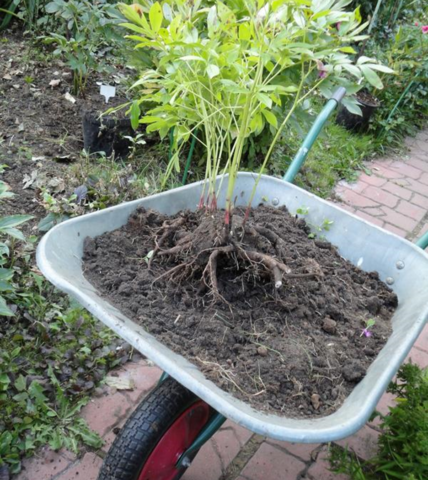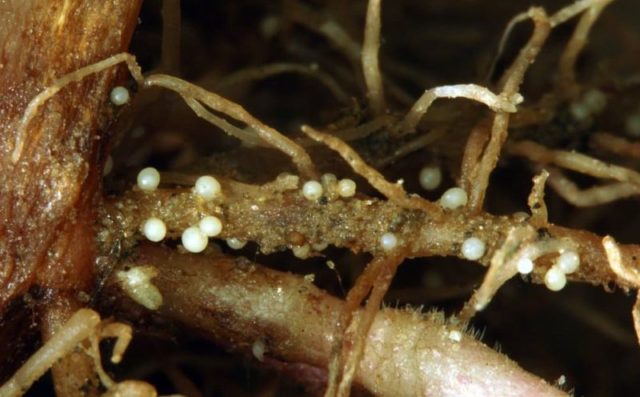Content
Peony Moon Over Barrington is a beautiful plant with an unusual name, which translates as "the moon over Barrington". Its origins lie in Illinois, where the variety was bred and first blossomed in 1986 in the nursery of the originator Roy Clem.
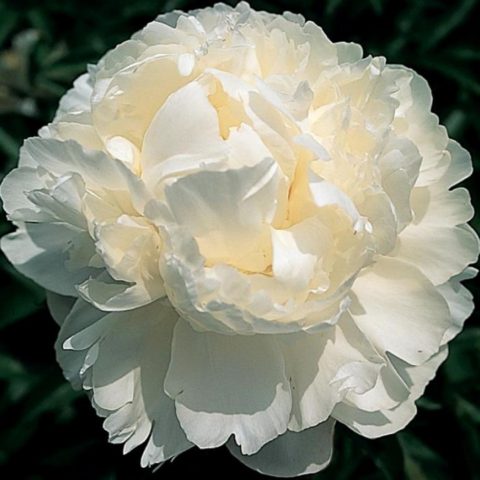
Peonies bred in the Midwest of the United States are characterized by large white buds.
Description of Peony Moon Over Barrington
The variety of American selection is quite rare and belongs to the "Collector" series. It is considered the largest among the milk-flowered peonies. The stable stem of a herbaceous perennial increases in size every year and can reach 1.5 m.
The shrub grows compact. Shoots grow in length quickly, in 40-45 days. The stems are covered with glossy dark green foliage. The large leaves of the Moon Over Barrington peony have a dissected shape with incisions reaching the midrib.
The thermophilic variety grows in places with a moderately warm climate, in the subtropics of Eurasia and North America. Peony Moon Over Barrington prefers well-lit and sun-warmed areas. In conditions of shade, the bushes are strongly elongated and bloom poorly.
The plant is characterized by relative frost resistance. Only new plantings should be covered for the winter. They are sprinkled with peat in a layer of 10-12 cm.
Under the weight of large buds, the stems often fall to the ground. To prevent this from happening, it is necessary to install supporting supports. It can be either an ordinary stick or a more complex structure in the form of a lattice or ring-shaped fence. Additional props will also protect the peony flower plantings from strong winds.
Flowering features
The main advantage of the double pink variety Moon Over Barrington is its large white buds, which reach a diameter of 20 cm and have a moderately spicy aroma. The flowers are shaped like a rose and consist of many compactly collected, wide petals. When opened, they take on a pink, creamy shade. Pistils and stamens are practically invisible, the pollen is sterile. Double flowers do not form seeds.
The large-flowered herbaceous peony of the Moon Over Barrington cultivar is characterized by a medium-late flowering period, which falls on June 24-29 and lasts 15-18 days. Terry buds are very suitable for forming bouquets.
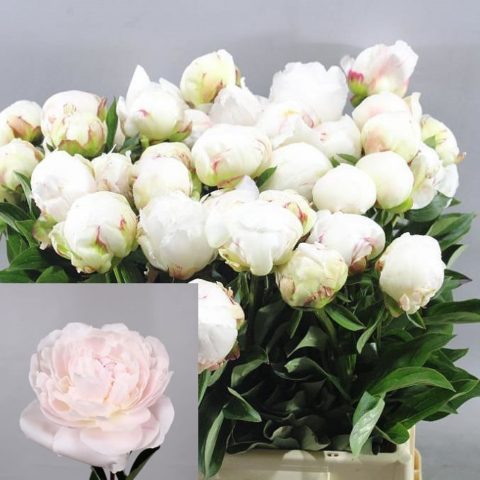
Moon Over Barrington flowers are beautifully shaped and stand in water for a long time
Timely removal of crumbling buds will create conditions for abundant flowering from season to season. Do not leave the petals under the bushes so as not to provoke the onset and spread of infection.
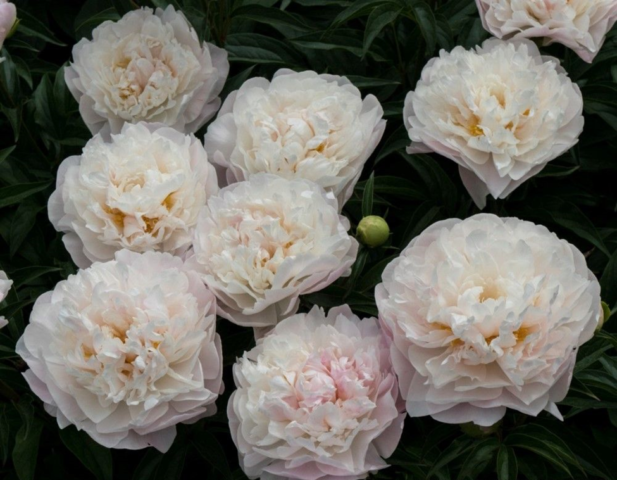
In order for the Moon Over Barrington peony to please with flowers of maximum sizes, it is recommended to remove the side buds
Application in design
Moon Over Barrington peonies are beautiful in both single and mixed plantings. They can be used to decorate the site, placing in groups among the lawn.
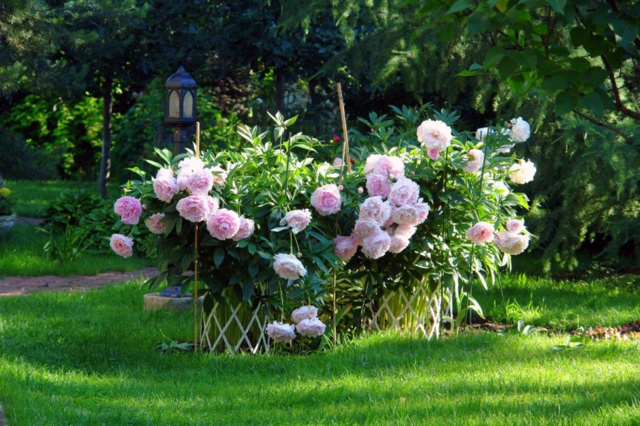
Flowerbeds with terry buds will become a bright accent of any area
You can not plant peonies under tree crowns, as well as next to lilacs, hydrangeas and other bushes characterized by a powerful root system.In the struggle for water and nutrients, Moon Over Barrington will be outdone by stronger competitors. Beautiful fragrant peonies do not tolerate tightness, so it is not recommended to plant them in flowerpots, on a balcony or loggia.

It is best to arrange plantings of peonies in an open space in the form of flower beds or along paths among similar varieties
Flowers planted in a flower bed must have the same requirements for growing conditions. The color range of plants can be varied. In summer, with Moon Over Barrington peonies, pelargoniums, lilies and petunias will look beautiful. In autumn, a combination with dahlias, asters and chrysanthemums is appropriate. During flowering, peonies will stand out from other plants, and then become a green background for them.
Reproduction methods
The Moon Over Barrington variety is propagated in several ways:
- The division of the bushes is carried out in late summer or early autumn. At this time, the peonies are at rest. The growth of the aerial part stops, the buds of renewal are already formed. The bush must be dug from all sides and completely pulled out of the ground, after cutting off the stems at a height of 20 cm. The root is shaken off the soil and divided into several parts with 2-5 buds on each. Sections should be covered with ash or crushed coal.
Reproduction of peonies by dividing the bush is the most effective
- Propagation by root cuttings is quite long. A part of the root about 10 cm long is buried in a pre-selected place, on which buds and roots will appear over time. The first flowering will come only 3-5 years after planting the cuttings.
- Peony Moon Over Barrington can also be propagated by green cuttings. For this, the stem is separated with a part of the root collar. In order not to weaken the mother bush, do not cut too many cuttings from one plant.
The variety does not form seeds, therefore it is not propagated in this way.
Landing rules
Considerable attention should be paid to the quality of the planting material. The optimal size of the cut is 20 cm. Each should have 2-3 buds. Do not plant cuttings with spoiled rotten areas. The selected rhizomes are soaked for an hour in a solution of potassium permanganate or a special preparation "Maxim". After drying, the cuts are sprinkled with wood ash.
Peonies are planted in the fall a month before the onset of cold weather, so that they have time to take root. Previously in the spring, it is necessary to dig planting holes measuring 60 * 60 * 60 cm.During this time, the nutrient layer of soil at the bottom will give seasonal shrinkage, which will further protect the buds of the seedlings from being pulled into the ground to a depth below the permissible level. This is essential for the normal flowering of Moon Over Barrington peonies in the spring.
To prepare the plants for winter, before planting, the bottom is filled 2/3 with a nutrient composition consisting of the following components:
- compost;
- priming;
- peat;
- rotted cow or horse manure.
The plots are placed in pits and covered with soil, into which ash, superphosphate or bone meal are added to maintain favorable alkaline or neutral acidity.
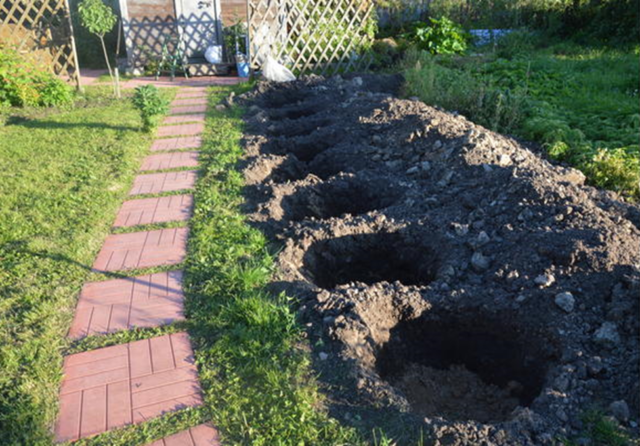
The pits for planting peonies should be spacious and well fertilized.
It is necessary to ensure that the buds are 2-3 cm below the soil level. The cuttings are covered with soil, compacted well and watered abundantly. If, over time, subsidence of the earth is observed, it should be poured so that the kidneys are not visible.
Follow-up care
For the first couple of years, Moon Over Barrington peonies do not need to be fertilized. They will have enough of those nutrients that were introduced into the planting pits at the time of planting. Caring for plants at this time should consist of timely watering, weeding and loosening the soil.
It is especially important to maintain an optimal level of soil moisture in early spring, during the period of growth and active flowering, as well as at the end of summer, when new buds are laid on Moon Over Barrington peonies.Watering should be carried out regularly, once a week, spending 25-40 liters of water for each adult bush. Better to use a watering can. In dry weather, watering should be daily. It is not recommended to use sprinklers, since water, when it hits the peonies, makes the buds heavier, they get wet and tend to the ground. They can develop stains and develop fungal diseases.
After watering or rain, the weeds are removed and the soil is loosened, this will create an oxygen-rich mulch layer around the flowers. Care should be taken not to damage the roots of Moon Over Barrington peonies. The depth of the grooves should not exceed 7 cm, and the distance from the bush should not exceed 20 cm.
When the peony reaches the age of 2 years, they begin to carry out regular feeding. In autumn or early spring, each bush is sprinkled with a bucket of compost. During flowering and bud formation, the soil is fertilized with a composition prepared from 10 liters of water and the following components:
- 7.5 g of ammonium nitrate;
- 10 g superphosphate;
- 5 g of potassium salt.
Preparing for winter
Before the onset of cold weather, damaged stems are cut from the bushes, dry leaves are collected and burned to prevent the spread of pests and viruses. The remaining stems on the bushes are sprinkled with ash.
2 weeks after the end of flowering, the peonies should be fed. Fertilization in the fall is necessary as the development of the root system continues. During this period, gardeners give preference to complex compounds, including phosphorus and potassium.
In late autumn, complete pruning of the stems is carried out, leaving several leaves on each. If the cut is made too close to the root, it will negatively affect the formation of future buds.
Peonies Moon Over Barrington are not afraid of winter cold. Young bushes can be covered with spruce branches, spruce branches or dry foliage.
Pests and diseases
The most common diseases of pions:
- Gray rot (botrytis) infects plants during growth. The stem at the base of Moon Over Barrington peonies becomes gray, darkens and breaks. Gardeners call this phenomenon "black leg".
The disease intensifies in a cold, damp spring.
- Rust... Yellow spore pads appear on the underside of the leaves. On the front surface, gray spots and bumps with a purple tint are formed.
A dangerous fungal disease affects peonies after flowering
- Ring mosaic... It manifests itself in the formation of yellow-green stripes and rings on the leaves between the veins.
When cutting flowers with one knife without processing, the mosaic virus is transferred from healthy bushes to sick ones.
- Cladosporium (brown spot). When lesions appear on the leaves
Leaves covered with brown spots take on a burnt appearance
Also, Moon Over Barrington peonies are exposed to powdery mildew infection. Fungal disease covers the foliage with a white coating.
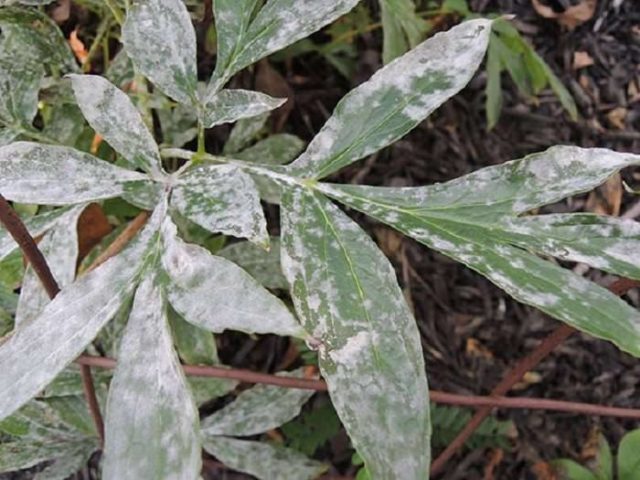
Powdery mildew appears only on adult peonies.
There are not so many pests in peonies. These include:
- Ants... These insects love the sweet syrup and nectar that fill the buds of Moon Over Barrington. They gnaw at the petals and sepals, preventing the flowers from blooming.
Ants can infect Peony Moon Over Barrington with fungal diseases
- Aphid... Large colonies of small insects weaken the plants by sucking out all the juices from them.
Sweet nectar released when buds are ripe attracts insect pests
- Nematodes... As a result of damage by dangerous worms, the roots of peonies are covered with nodular swellings, and the leaves are yellow spots.
Frequent spraying promotes the spread of leaf nematodes
Timely treatment of peonies with protective preparations will prevent their death.
Conclusion
Peony Moon Over Barrington is a collectible cultivar characterized by large double white buds.During the flowering period, a plant planted in flower beds or along paths will decorate any garden area. Cut buds are perfect for forming festive bouquets. Unpretentious care makes this variety even more attractive to gardeners.
Peony Moon Over Barrington reviews
